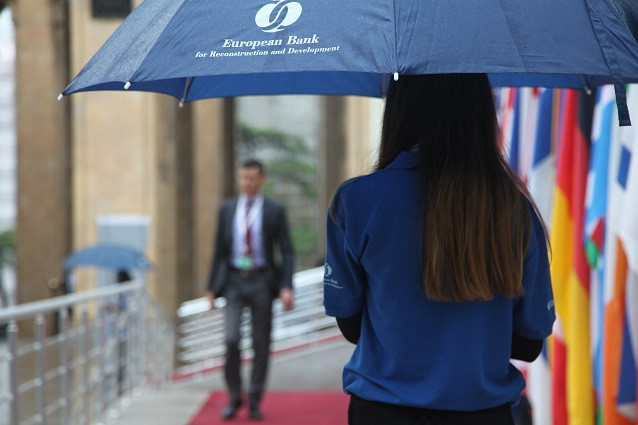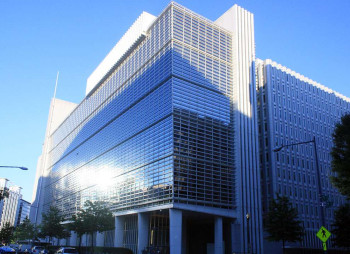- In Ukraine, growth is seen at by 2% 2017 and 3% in 2018 (2016 2.3%) *
- Household consumption picking up on higher real wages and improving confidence
- Gross fixed capital formation continuing to grow robustly after downturn
- Falling real exports are weighing on GDP growth
- Industrial production down 0.4% in first 8 months of 2017 as a result of economic blockade of area that is beyond the control of the government
- CPI slowing but remaining high at Y/Y 16.4 % in September 2017.
- Successful sovereign Eurobond issue Marked Ukraine’s return to international capital markets.
- Banking system still has been stabilising but lending remains weak on risk-aversion, deleveraging, lack of progress in creditor rights protection and high (but falling) interest rates.
- “The IMF completed the third programme review in April 2017 although continuation of the IMF programme is uncertain due to weak reform momentum.”
*EBRD forecast in May 2107 - 2.0%; 2018 - 3.0%
The EBRD Regional Economic Prospects forecast says the Ukraine economy will grow by 2 per cent in 2017 and by 3 per cent in 2018. Better household consumption, higher real wages and gross fixed capital growth are named among influence factors.
At the same time the report notes falling real exports and industrial production. Consumer Price Inflation (CPI) remains high, at 16 per cent year-on-year, in September 2017. Ukraine’s banking system has been stable but lending to real sector remains weak. The report commends Ukraine for its successful return to international capital markets with a sovereign Eurobond issue but warns that the continuation of the IMF programme for Ukraine is uncertain due to uncertainty with reforms.
The EBRD has revised up sharply its 2017 economic growth forecasts, with higher export levels, a revival in investment and firmer commodity prices supporting a broad-based upswing.
Average growth across the EBRD region is seen at 3.3 per cent this year, a rise of 0.9 percentage points against the previous forecast from May, and compared with growth of just 1.9 per cent in 2016.
The EBRD tracks the economies of 37 emerging countries, where it finances projects and supports reforms that promote sustainable and environmentally-friendly market economies.
The pace of growth has picked up in 27 of the EBRD’s economies this year, the first time that such a broad upturn has been seen since 2010. All economies in the region, except Azerbaijan and FYR Macedonia, saw positive growth in the first half of the year.
Several countries, notably Romania and Turkey, are enjoying growth rates comparable to the pre-crisis levels of the mid-2000s.
The EBRD’s chief economist Sergei Guriev said: “The broad-based recovery is a very welcome development. It also creates a window of opportunity to carry out reforms that will ensure the sustainability of the stronger growth rates over the longer term.”
Growth across the region is expected to continue into 2018, but at a slightly more moderate pace of 3.0 per cent.
Despite the recent acceleration in economic output, the EBRD expects average growth in the region to remain slightly below that of other comparable emerging markets.
It also says the current outlook is subject to numerous risks, including geopolitical tensions, persistent security threats, the growing appeal of populist anti-globalisation policies in advanced economies and a high degree of concentration in the sources of global growth.
The economy in Russia, the largest in the EBRD region and a major influence on output in many other EBRD countries of operations, has now pulled out of recession after a cumulative contraction of 3 per cent over the last two years. Russia is expected to see GDP growth of 1.8 and 1.7 per cent in 2017 and 2018, respectively.
The increase in the oil price – compared with 2016 – has been a positive factor for Russia, and also for other commodity exporters and countries in Central Asia and eastern Europe and the Caucasus that rely on Russia for remittance flows or as a destination for their exports.
The gap in growth rates between the east and west of the EBRD region was now expected to narrow further, it added.
However, the report says that investment activity in Russia is constrained by economic uncertainty, and signs of stress have appeared in the financial sector.
After a slow-down in 2016 linked to lower investment levels, growth in central Europe and the Baltic states is expected to accelerate to close to 4 per cent in 2017, before moderating to around 3.5 per cent in 2018.
In this sub-region, skilled labour shortages may act as a constraint on potential growth in the medium term.
In Poland, where growth is seen rising to 4.1 per cent this year, the pace will slow to 3.4 per cent as the one-off impact of increased social payments fades.
The near-term economic outlook has improved in Hungary on the back of cuts in the rates of personal income tax and social security contributions as well as increases in public wages.
In south-eastern Europe, average growth is also expected to accelerate, reaching 3.6 per cent in 2017 before moderating to 3.3 per cent in 2018. The Greek economy has returned to growth in the first half of the year amid progress in reforms and rising confidence.
Growth in eastern Europe and the Caucasus as a whole is expected to pick up from near zero to close to 1.5 per cent in 2017 as headwinds from low commodity prices and the earlier recession in Russia subside, although Azerbaijan’s economy is projected to remain in recession. A gradual recovery in the region is set to continue in 2018.
Growth in Turkey is projected to accelerate to 5.1 per cent in 2017 on the back of government stimulus before slowing to 3.5 per cent in 2018 as the fiscal impact wears off.
Economies in the southern and eastern Mediterranean (SEMED) region are expected to show growth of 3.8 per cent in 2017 and 4 per cent in 2018, supported by reform implementation and continued recovery in the tourism sector, and export rebounds in Egypt and Jordan.
Morocco is the only country in the SEMED region that is expected to see a slow-down in growth during 2018, as the base effect from the agricultural rebound in 2017 (after a very poor 2016) is removed.
|
Actual |
Forecast |
Change in forecast |
||||||||||||
|
(as of 7 Nov 17) |
since May 2017 |
|||||||||||||
|
2015 |
2016 |
2017 |
2018 |
2017 |
2018 |
|||||||||
|
EBRD Region1 |
1.3 |
1.9 |
3.3 |
3.0 |
0.9 |
0.2 |
||||||||
|
Central Europe and the Baltic states |
3.5 |
2.8 |
3.9 |
3.4 |
0.8 |
0.3 |
||||||||
|
Croatia |
2.3 |
3.0 |
2.9 |
2.6 |
0.0 |
0.0 |
||||||||
|
Estonia |
1.7 |
2.1 |
3.7 |
3.4 |
1.3 |
0.7 |
||||||||
|
Hungary |
3.4 |
2.2 |
3.8 |
3.4 |
0.8 |
0.4 |
||||||||
|
Latvia |
2.8 |
2.1 |
4.7 |
4.1 |
1.6 |
0.9 |
||||||||
|
Lithuania |
2.0 |
2.3 |
3.6 |
3.5 |
0.7 |
0.5 |
||||||||
|
Poland |
3.8 |
2.9 |
4.1 |
3.4 |
0.9 |
0.2 |
||||||||
|
Slovak Republic |
3.9 |
3.3 |
3.3 |
3.5 |
0.1 |
0.0 |
||||||||
|
Slovenia |
2.3 |
3.1 |
4.0 |
2.9 |
1.5 |
0.7 |
||||||||
|
South-eastern Europe |
2.4 |
2.9 |
3.6 |
3.3 |
0.5 |
0.3 |
||||||||
|
Albania |
2.2 |
3.4 |
3.7 |
3.7 |
0.2 |
0.0 |
||||||||
|
Bosnia and Herzegovina |
3.1 |
3.2 |
2.5 |
3.0 |
0.0 |
0.0 |
||||||||
|
Bulgaria |
3.6 |
3.9 |
3.5 |
3.2 |
0.3 |
0.2 |
||||||||
|
Cyprus |
2.0 |
3.0 |
3.5 |
2.5 |
1.0 |
0.3 |
||||||||
|
FYR Macedonia |
3.8 |
2.4 |
1.5 |
2.5 |
-0.9 |
-0.5 |
||||||||
|
Greece |
-0.3 |
-0.2 |
2.0 |
2.2 |
0.0 |
0.0 |
||||||||
|
Kosovo |
4.0 |
3.4 |
3.7 |
3.5 |
0.2 |
0.0 |
||||||||
|
Montenegro |
3.4 |
2.9 |
3.7 |
3.3 |
0.7 |
0.0 |
||||||||
|
Romania |
4.0 |
4.6 |
5.3 |
4.2 |
1.3 |
0.7 |
||||||||
|
Serbia |
0.8 |
2.8 |
1.8 |
2.9 |
-1.1 |
-0.1 |
||||||||
|
Eastern Europe and the Caucasus |
-4.8 |
0.1 |
1.6 |
2.7 |
0.5 |
0.2 |
||||||||
|
Armenia |
3.2 |
0.2 |
3.5 |
3.5 |
1.0 |
0.5 |
||||||||
|
Azerbaijan |
1.1 |
-3.1 |
-0.5 |
2.0 |
0.0 |
0.0 |
||||||||
|
Belarus |
-3.8 |
-2.6 |
1.5 |
2.0 |
2.0 |
1.0 |
||||||||
|
Georgia |
2.9 |
2.7 |
4.5 |
4.5 |
0.6 |
0.3 |
||||||||
|
Moldova |
-0.4 |
4.3 |
3.0 |
3.5 |
0.0 |
0.0 |
||||||||
|
Ukraine |
-9.8 |
2.3 |
2.0 |
3.0 |
0.0 |
0.0 |
||||||||
|
Turkey |
6.1 |
3.2 |
5.1 |
3.5 |
2.5 |
0.5 |
||||||||
|
Russia |
-2.8 |
-0.2 |
1.8 |
1.7 |
0.6 |
0.3 |
||||||||
|
Central Asia |
3.7 |
3.6 |
4.5 |
4.4 |
0.7 |
-0.1 |
||||||||
|
Kazakhstan |
1.2 |
1.1 |
3.8 |
3.5 |
1.4 |
0.0 |
||||||||
|
Kyrgyz Republic |
3.9 |
3.8 |
4.4 |
4.2 |
0.5 |
0.1 |
||||||||
|
Mongolia |
2.4 |
1.0 |
2.6 |
3.0 |
1.2 |
0.2 |
||||||||
|
Tajikistan |
6.0 |
6.9 |
6.5 |
5.0 |
2.7 |
1.0 |
||||||||
|
Turkmenistan |
6.5 |
6.2 |
5.7 |
5.1 |
0.0 |
-0.9 |
||||||||
|
Uzbekistan |
8.0 |
7.8 |
5.4 |
6.2 |
-0.8 |
-0.3 |
||||||||
|
Southern and Eastern Mediterranean2 |
3.9 |
3.3 |
3.8 |
4.0 |
0.1 |
-0.1 |
||||||||
|
Egypt |
4.4 |
4.3 |
4.1 |
4.5 |
0.3 |
0.0 |
||||||||
|
Jordan |
2.4 |
2.0 |
2.3 |
2.5 |
0.0 |
0.0 |
||||||||
|
Lebanon |
0.8 |
1.0 |
2.3 |
2.5 |
||||||||||
|
Morocco |
4.6 |
1.2 |
4.2 |
3.5 |
0.0 |
-0.3 |
||||||||
|
Tunisia |
1.1 |
1.0 |
2.2 |
2.7 |
0.0 |
0.0 |
||||||||






